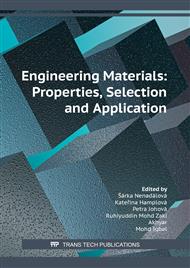[1]
W Peng, J Zhang, X Yang, Z Zhu, S Liu, Failure analysis of the leaf spring of truck colt diesel using finite element method, Eng. Fail. Anal. 17 (2019) 971-978.
Google Scholar
[2]
M P Jenerthanan, R S Kumar, G Vankatesh, S Nishantan, Analysis of leaf spring using carbon/ Glass Epoxy and EN45 using ANSYS; A comparison, Materialstoday: Proc. 5(2018) 14512-14519.
DOI: 10.1016/j.matpr.2018.03.039
Google Scholar
[3]
T Hidayat, Analysis of leaf spring failure on Toyota Kijang Kapsul 7KE, J. Mech, Elect, and Comp. Sci. Eng. (in Indonesian) 1 (2012) 1-8.
Google Scholar
[4]
I Thamrin, Analysis of the stress-strain structure of leaf springs due to compression modification, J. Mech. Eng. ( Indonesia: Faculty of Engineering, Sriwijaya University) 9 (2009) 18-22.
Google Scholar
[5]
B G Scuracchio, N B de Lima, C G Schin, Role of residual stress induced by double peening on fatigue durability of automotive leaf springs, Mater. & Des. 47 (2013) 672-676.
DOI: 10.1016/j.matdes.2012.12.066
Google Scholar
[6]
T E Putra, Husaini, Identifying strain signal characteristics of automotive suspension system subjected to road surface vibrations, AIP Conf. Proc. 1983(2018) 030004.
DOI: 10.1063/1.5046239
Google Scholar
[7]
Sepitraf, Y Rizal, Analysis of failure events on leaf springs of Diesel trucks carrying sand APTEK J. (in Indonesian) 5 (2013) 151-159.
Google Scholar
[8]
Husaini, T E Putra, N Ali, Fatigue feature clustering of modified automotive strain signals for saving testing time, Int. J. Auto. and Mech. Eng. 15 (2018) 5251-5272.
DOI: 10.15282/ijame.15.2.2018.8.0405
Google Scholar
[9]
M T Todinov, Maximum principal tensile stress and fatigue crack for compression springs, Int. J. Mech. Sci. Int. J. Mech. Sci. 41 (1999) 375-370.
DOI: 10.1016/s0020-7403(98)00068-x
Google Scholar
[10]
Husaini, R Riantoni, N Ali, T E Putra, Study of leaf spring fracture behavior used in the suspension system in the diesel truck vehicles IOP Conf. Ser: Mater. Sci. Eng 547 (2019) 012017.
DOI: 10.1088/1757-899x/541/1/012046
Google Scholar
[11]
C K Clarke, Evaluation of a leaf spring failure, J. Fail. Anal. and Prev. 5 (2005) 54-63.
Google Scholar
[12]
D Pastorcic, G Vulkelic, Coil spring failure and Fatigue analysis Z Bozic Eng. Fail. Anal. 99 (2019) 310-318.
DOI: 10.1016/j.engfailanal.2019.02.017
Google Scholar
[13]
G Vulkelic, B Marino, Failure Analysis of a motor vehicle coil Spring, Proc. Str. Integ. 2 (2016) 2944-2950.
Google Scholar
[14]
I B Eryurek, M Ereke, A Goksenli, Failure analysis of the suspension spring of a light duty truck, Eng. Fail. Anal 14 (2007) 170-178.
DOI: 10.1016/j.engfailanal.2005.11.007
Google Scholar
[15]
Husaini, N Ali, A Bakhtiar, Analysis on the surface of broken screw spring front car suspension, National Seminar on Eng. Tech.(in Indonesian) III 1 (2016) 111-117.
Google Scholar
[16]
E Sutikno, Stress analysis due to static loading on the Carbody TeC Railbus design using the finite element method, Mech. Eng. J. (in Indonesian) 2 (2011) 65-81.
Google Scholar
[17]
M Sousia, Analysis of the modulus of elasticity and poisson ratio of materials with tensile test, J. App. Math. (in Indonesian) 5 (2011) 9-14.
Google Scholar
[18]
Husaini, Fundamentals of Fracture Mechanic, (Indonesia: Faculty of Engineering, Syiah Kuala University Press ), (2015).
Google Scholar
[19]
Husaini, Zuhaimi, Mixed mode fracture behavior of an aluminum alloy A6061 investigated by using compact tension shear specimens, Int. J. Tech. 7 (2016) 456-462.
DOI: 10.14716/ijtech.v7i3.1924
Google Scholar
[20]
Husaini, K Kishimoto, M Hanji, M Notomi, Investigations of the mixed mode crack growth behavior of an aluminum alloy, ARPN J. Eng. and App. Sci. 11 (2016) 885-890.
Google Scholar
[21]
J C Newman Jr, S R Daniewicz, Predicting crack growth in specimens with overloads and coltworked holes with residual stresses, Eng. Frac. Mech. 127 (2014) 252-266.
DOI: 10.1016/j.engfracmech.2014.06.012
Google Scholar
[22]
S S Rao, The Finite Element Method in Engineering, fourth ed., (Amsterdam: Elsevier) (2005).
Google Scholar
[23]
AZOM Materials. AISI 5150 alloy stell, information on https://www.azom.com/aboutus.aspx (accessed on 6-8-2021).
Google Scholar
[24]
A Samoila, Liftning for lifting of the locomotive with bogies, (Swedish: Faculty of Technology and Science, Och Naturvetenskap) (2011).
Google Scholar



